Abstract
OBJECTIVE--To assess whether physical growth is affected in early treated Dutch patients with phenylketonuria (PKU). METHODS--The birth weights of all 137 early detected patients with PKU born in the period from 1974 to 1988 in the Netherlands were compared with reference values. Height, head circumference, and weight were measured at the age at which treatment started (commonly about 2-3 weeks), at 6 months of age, and yearly from the child's first birthday up to the age of 10 years. These measurements were compared with reference values. RESULTS--The adjusted birth weight in patients with PKU was 141 g (95% confidence interval (CI) 66 to 216 g) less than Dutch reference values by Kloosterman and 103 g (95% CI 9 to 196 g) less compared with the birth weight of another reference group. At the age at which treatment started, z scores of patients for height by age were -0.23 (95% CI -0.44 to -0.02) and z scores for head circumference by the age were -0.25 (95% CI -0.44 to -0.06). From the age at which treatment started up to the age of 3 years z scores for height by age further decreased to -0.74 (95% confidence interval -0.93 to -0.56), after which no additional decrease occurred. In contrast, z scores for head circumference increased from -0.25 at the first visit to 0.08 (95% CI -0.14 to 0.30) at the age of 1 year, after which they remained close to zero. Weight by height was close to the expected centiles for all ages. CONCLUSION--Patients with PKU are growth retarded at birth and have smaller head circumferences than the normal population. In Dutch patients further growth retardation occurs in the first three years of life.
Full text
PDF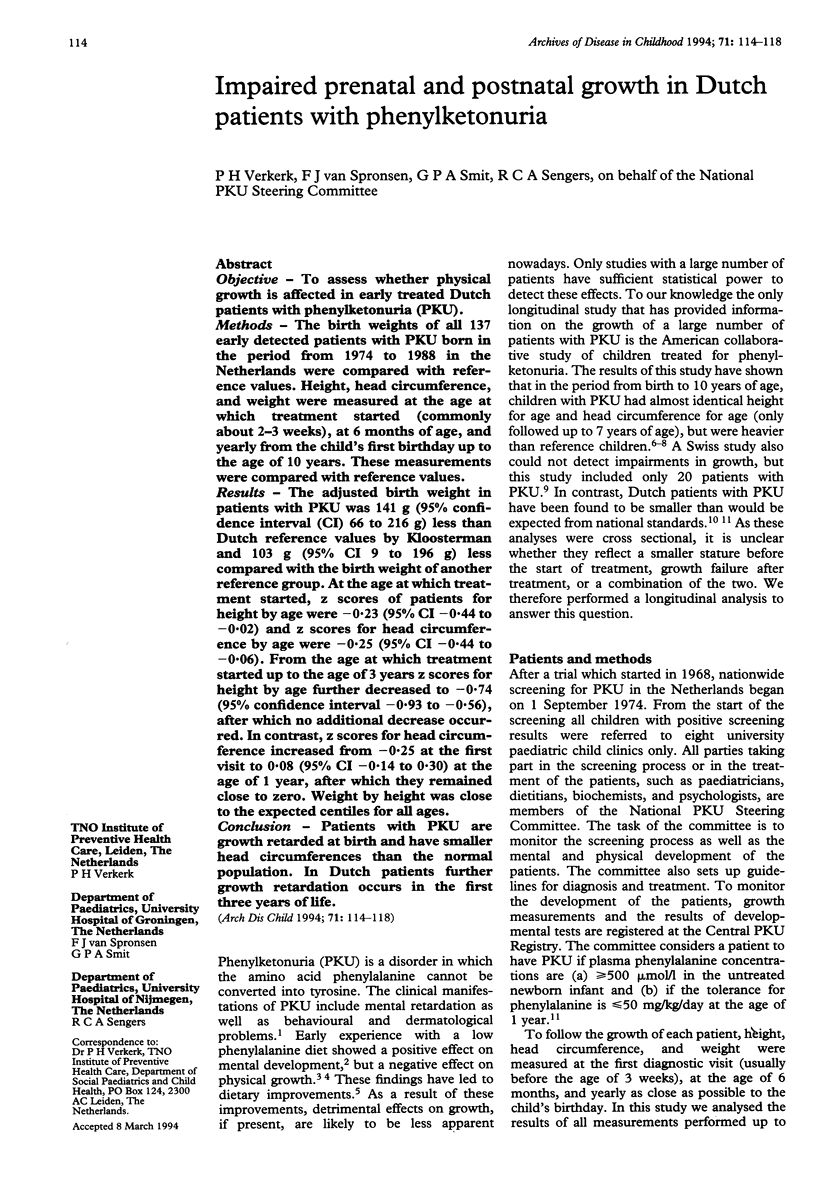
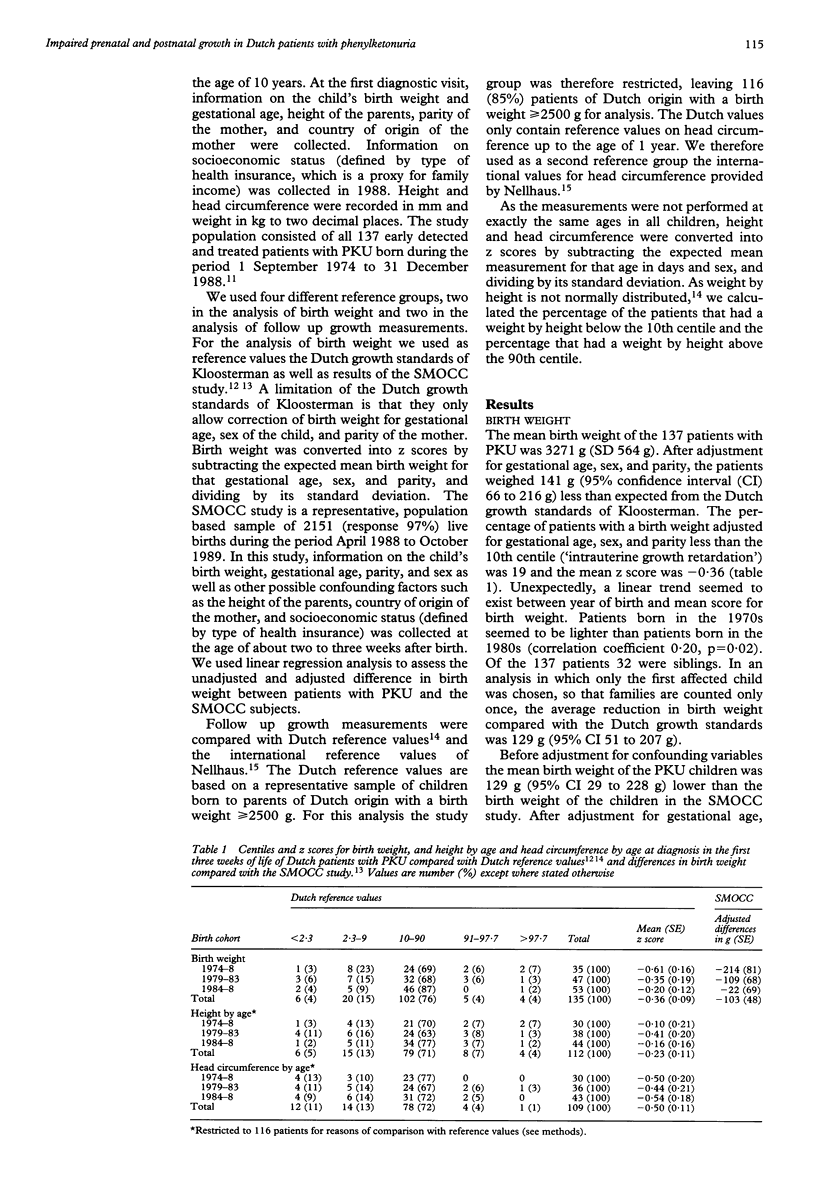
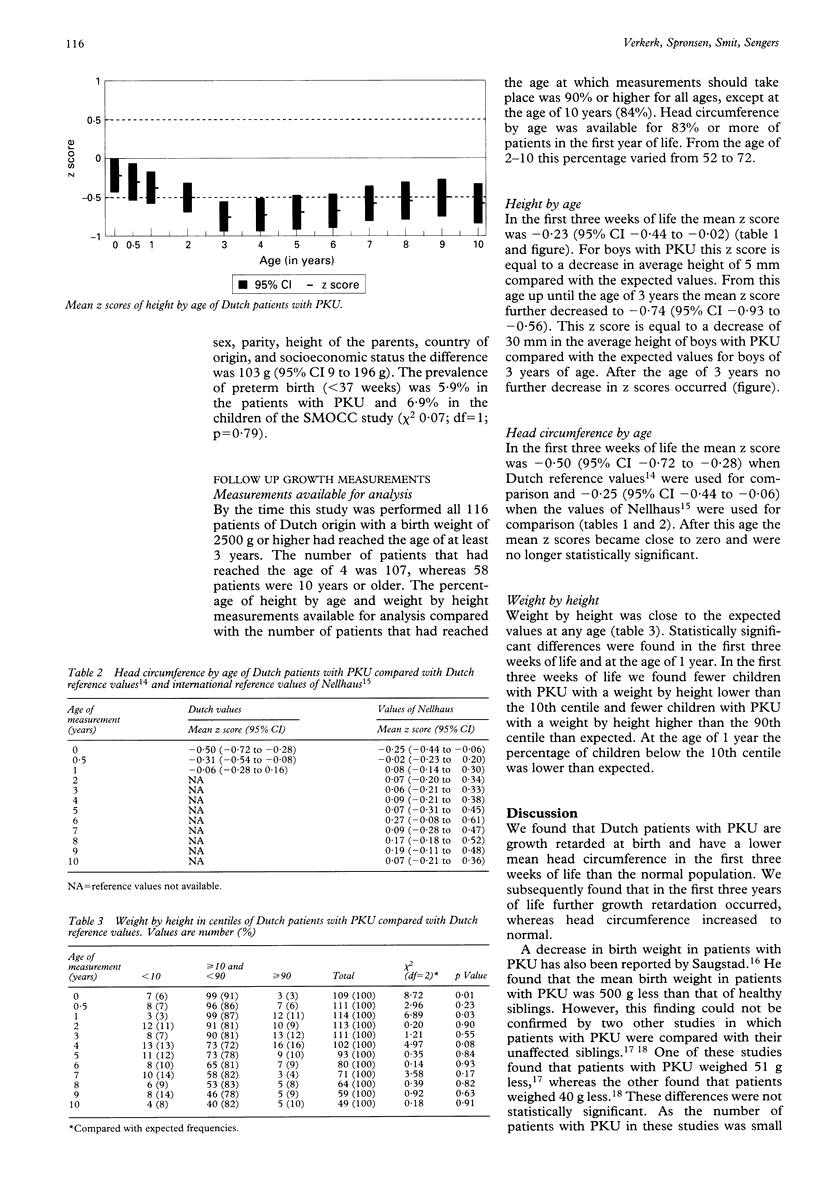
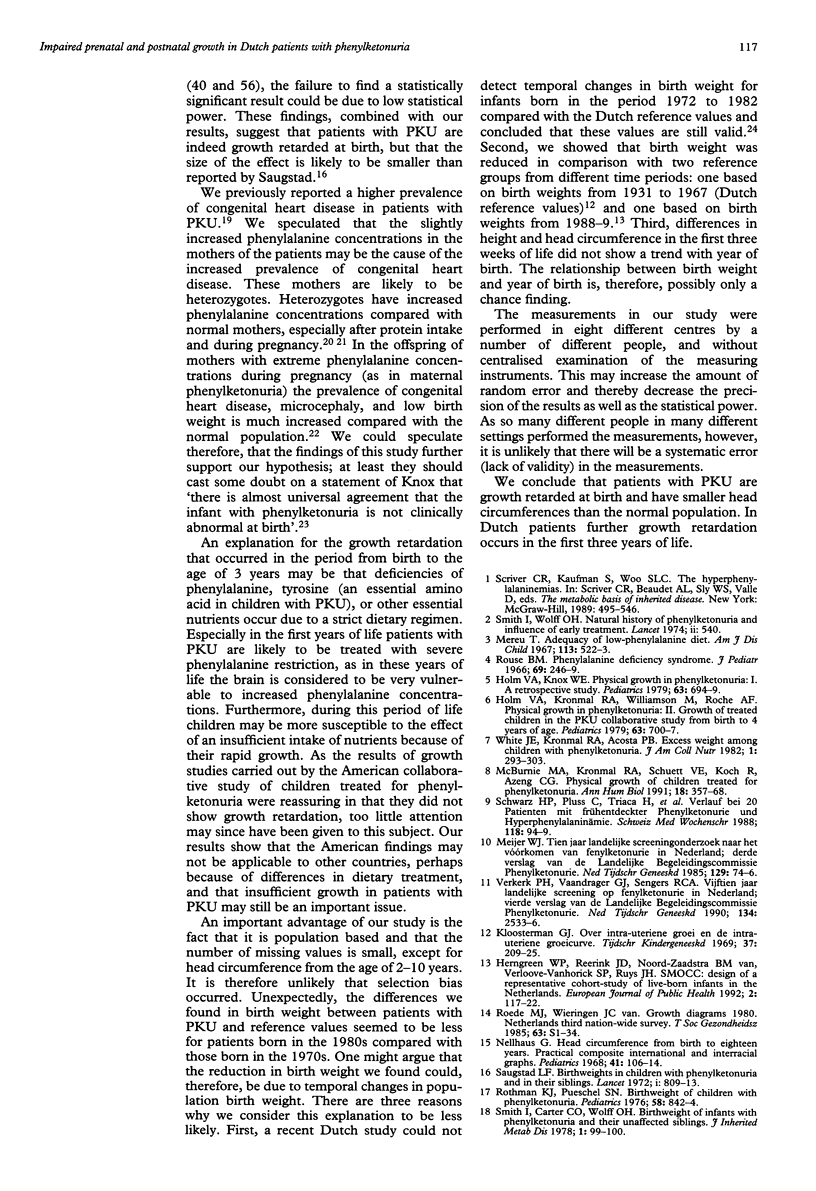
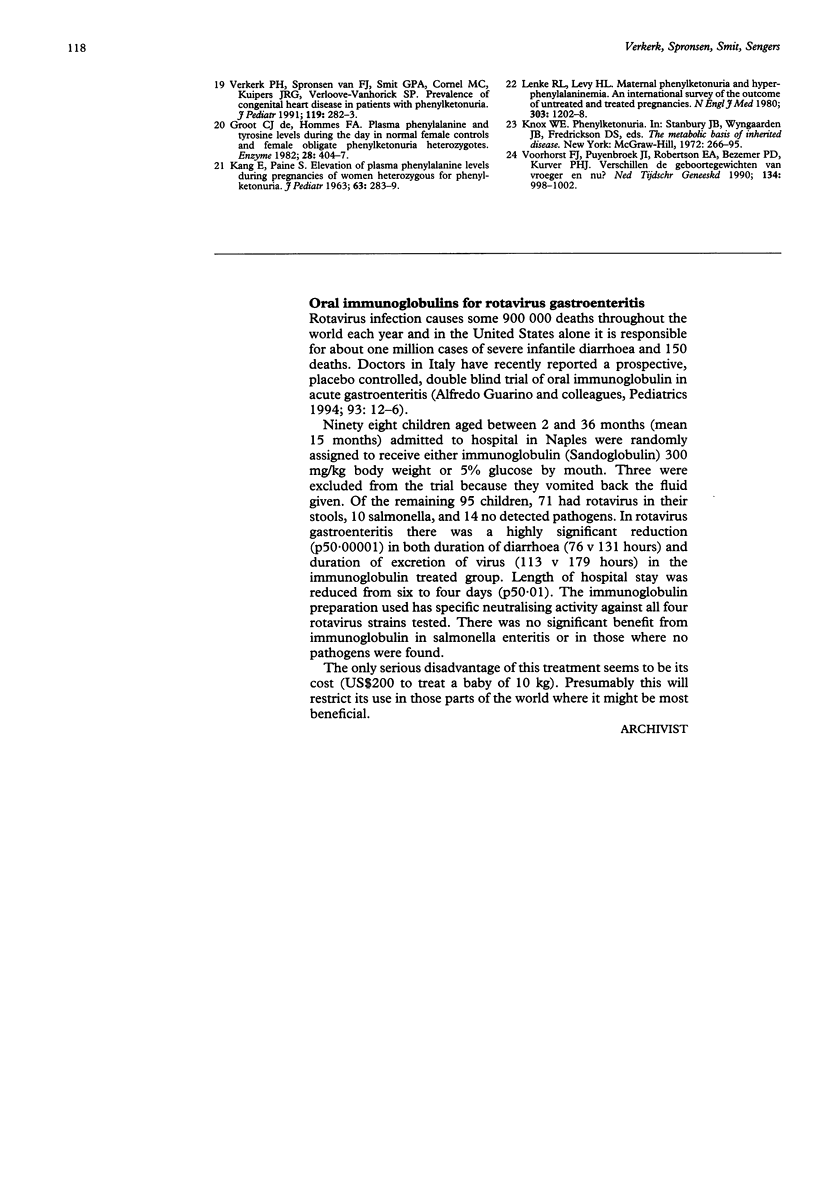
Selected References
These references are in PubMed. This may not be the complete list of references from this article.
- De Groot C. J., Hommes F. A. Plasma phenylalanine and tyrosine levels during the day in normal female controls and female obligate phenylketonuria heterozygotes. Enzyme. 1982;28(4):404–407. doi: 10.1159/000459132. [DOI] [PubMed] [Google Scholar]
- Holm V. A., Knox W. E. Physical growth in phenylketonuria: I. A retrospective study. Pediatrics. 1979 May;63(5):694–699. [PubMed] [Google Scholar]
- Holm V. A., Kronmal R. A., Williamson M., Roche A. F. Physical growth in phenylketonuria: II. Growth of treated children in the PKU collaborative study from birth to 4 years of age. Pediatrics. 1979 May;63(5):700–707. [PubMed] [Google Scholar]
- Kloosterman G. J. Over intra-uteriene groei en de intrauteriene groeicurve. Maandschr Kindergeneeskd. 1969 Dec;37(7):209–225. [PubMed] [Google Scholar]
- Lenke R. R., Levy H. L. Maternal phenylketonuria and hyperphenylalaninemia. An international survey of the outcome of untreated and treated pregnancies. N Engl J Med. 1980 Nov 20;303(21):1202–1208. doi: 10.1056/NEJM198011203032104. [DOI] [PubMed] [Google Scholar]
- McBurnie M. A., Kronmal R. A., Schuett V. E., Koch R., Azeng C. G. Physical growth of children treated for phenylketonuria. Ann Hum Biol. 1991 Jul-Aug;18(4):357–368. doi: 10.1080/03014469100001662. [DOI] [PubMed] [Google Scholar]
- Meijer W. J. Tien jaar landelijk screeningonderzoek naar het vórkomen van fenylketonurie in Nederland; derde verslag van de Landelijke Begeleidingscommissie Phenylketonurie. Ned Tijdschr Geneeskd. 1985 Jan 12;129(2):74–76. [PubMed] [Google Scholar]
- Mereu T. Adequacy of low-phenylalanine diet. Am J Dis Child. 1967 May;113(5):522–523. doi: 10.1001/archpedi.1967.02090200054002. [DOI] [PubMed] [Google Scholar]
- Nellhaus G. Head circumference from birth to eighteen years. Practical composite international and interracial graphs. Pediatrics. 1968 Jan;41(1):106–114. [PubMed] [Google Scholar]
- Rothman K. J., Pueschel S. N. Birthweight of children with phenylketonuria. Pediatrics. 1976 Dec;58(6):842–844. [PubMed] [Google Scholar]
- Rouse B. M. Phenylalanine deficiency syndrome. J Pediatr. 1966 Aug;69(2):246–249. doi: 10.1016/s0022-3476(66)80327-x. [DOI] [PubMed] [Google Scholar]
- Saugstad L. F. Birthweights in children with phenylketonuria and in their siblings. Lancet. 1972 Apr 15;1(7755):809–813. doi: 10.1016/s0140-6736(72)90797-0. [DOI] [PubMed] [Google Scholar]
- Schwarz H. P., Plüss C., Triaca H., Schütz B., Kaufmann R., Scherz R., Bachmann C., Zuppinger K. Verlauf bei 20 Patienten mit frühentdeckter Phenylketonurie und Hyperphenylalaninämie. Schweiz Med Wochenschr. 1988 Jan 23;118(3):94–99. [PubMed] [Google Scholar]
- Smith I., Carter C. O., Wolfe O. H. Birthweight of infants with phenylketonuria and their unaffected siblings. J Inherit Metab Dis. 1978;1(3):99–100. doi: 10.1007/BF01805681. [DOI] [PubMed] [Google Scholar]
- Smith I., Wolff O. H. Natural history of phenylketonuria and influence of early treatment. Lancet. 1974 Sep 7;2(7880):540–544. doi: 10.1016/s0140-6736(74)91873-x. [DOI] [PubMed] [Google Scholar]
- Verkerk P. H., Vaandrager G. J., Sengers R. C. Vijftien jaar landelijke screening op fenylketonurie in Nederland; vierde verslag van de Landelijke Begeleidingscommissie Phenylketonurie. Ned Tijdschr Geneeskd. 1990 Dec 29;134(52):2533–2536. [PubMed] [Google Scholar]
- Verkerk P. H., van Spronsen F. J., Smit G. P., Cornel M. C., Kuipers J. R., Verloove-Vanhorick S. P. Prevalence of congenital heart disease in patients with phenylketonuria. J Pediatr. 1991 Aug;119(2):282–283. doi: 10.1016/s0022-3476(05)80743-7. [DOI] [PubMed] [Google Scholar]
- Voorhorst F. J., Puyenbroek J. I., Robertson E. A., Bezemer P. D., Kurver P. H. Verschillen de geboortegewichten van vroeger en nu? Ned Tijdschr Geneeskd. 1990 May 19;134(20):998–1002. [PubMed] [Google Scholar]
- White J. E., Kronmal R. A., Acosta P. B. Excess weight among children with phenylketonuria. J Am Coll Nutr. 1982;1(3):293–303. doi: 10.1080/07315724.1982.10718998. [DOI] [PubMed] [Google Scholar]


